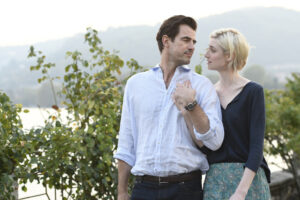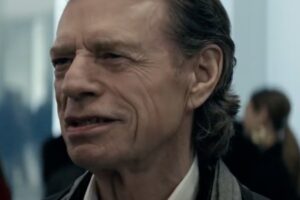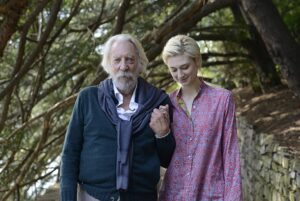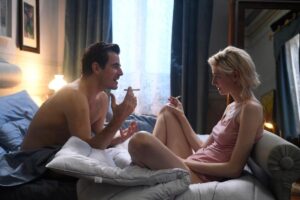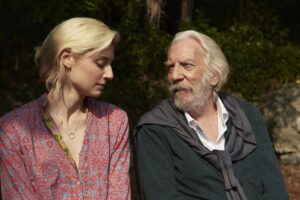Directed by Giuseppe Capotondi | Written by Scott B Smith based on the novel by Charles Willeford | 99 min | On Demand and Crave Plus
Here’s something that will give you an idea of my cinematic dietary preferences: I’ll solidly recommend a flawed European thriller with more than a little Hitchcock and Highsmith in its DNA than a so-called great film in any number of other genres. The Burnt Orange Heresy won’t be making a lot of end-of-year Top 10 lists, but if your appetites include a couple of shallow, manipulative-but-sexy leads in Italian villas discussing the value of art and deceit, this is for you.
People keep calling James Figueras (Claes Bang, returning to the art world milieu of The Square, with fewer laughs) a young man, which makes me wonder if the character was more youthful in the book — Bang is clearly in his 40s, if not 50s, but he channels a wiry, intense energy as a problematic art critic, justifying his career with regular talks celebrating his ability to spin bullshit, all while hooked on prescription pills.
His louche, roguish sleaze is enough to earn the attention of Berenice Hollis (Elizabeth Debicki, more impressive with every role), a mysterious American — an icy blonde helping sprinkle the Hitchcock spice — who may or may not be a teacher on a forced sabbatical from her day job in Minnesota. They’re invited by a (surprisingly short) Mick Jagger, flashing a serpentine grin as Joseph Cassidy, an art dealer who enlists Figueras to lure a reclusive but legendary painter (Donald Sutherland) out into the light of publicity, and secure one of his new works.
Structurally, not all of this impresses, and the stakes for Figueras aren’t entirely clear. More time spent understanding his circumstances early on would help explain some of his more desperate behaviour later. The film really enjoys its swipes at the culture of the art world in general before it gets really nasty late in the running.
If you’re going to have trouble with this, it’ll be in the last act, when one character in particular makes a bad decision and then doubles down on it, which will have you wondering whether any of their cleverness early on was legit.
Characters drape across one another, wearing very little and smoking — which, while still strangely appealing, means something entirely different in 2020 than it did last century. Then it was sexy and dangerous, now it’s a sign of a character not entirely in control of their appetites, and willing to look slightly ugly because of it.
But by the end you’re either on board with what’s going on or you’re not. The fact is, Bang and Debicki have chemistry off the periodic table; I’d have watched a whole movie of their verbal (and other modes of) jousting as they tour northern Italy like a sexier version of The Trip.
We don’t get enough of that. but we do get a couple scenes of Jagger going full ham and Sutherland’s ever-present gleam. Give in to The Burnt Orange Heresy and you may enjoy its pretensions and creative convolutions as much as I did.








